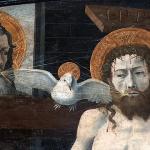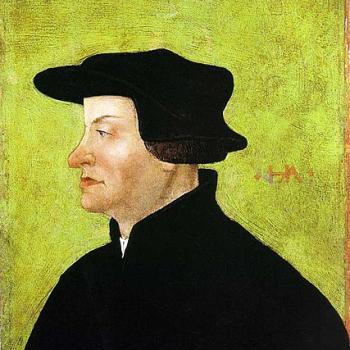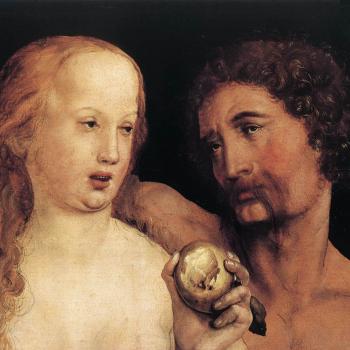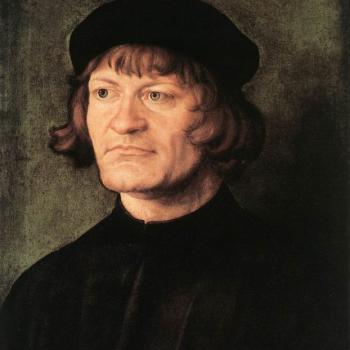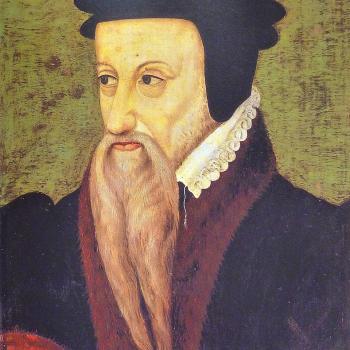![]()
Calvinists and other Protestants sometimes argue as follows:
1. The Church needed reform (particularly its hierarchical leaders).
2. Traditional, crucifixes, stained glass, church architecture, organs, music, and painting and art in general are good things (hidden common assumption). Maybe statues are idols, but all this other stuff is good and wholesome.
3. These were destroyed by the so-called “reformers” because the Church (and/or the people in it) was corrupt.
4. Therefore, the primary blame for such “artistic devastation” and “excesses” lies with the Catholics who believed in these things, rather than the Protestants who destroyed them and who thought that organs and stained glass were idolatrous, etc.
I don’t understand this. Can anyone explain it to me? I don’t have the foggiest comprehension of the nature and rationale of #3 or how and why #4 supposedly follows from #1-3. Protestants too often refuse to blame the “Reformers” at all for all this artistic philistinism and hostility to beauty and the visual. They think the blame should lie with Catholics, if anyone is to be blamed.
By analogy, we could reason, following this logic:
1. Czarist Russia needed reform in 1917 (particularly its governmental leaders).
2. The government and previously broadly Christian-based traditional way of life was destroyed by Lenin and the Communists because the Czar and his minions were corrupt.
3. Therefore, the primary blame for such cultural “devastation” and “excesses” (such as destroying churches and killing Orthodox priests by the thousands) lies with the Orthodox Russians who believed in these things, rather than the Communists who destroyed them and who thought Christianity was the “opiate of the masses,” etc.
Thus, Lenin’s Communist revolution is ethically and logically justified by the corruptions of the Czarist regime (and indeed this is how he and subsequent Marxists / Communists would justify it, per Marxist ideology). All the nonsense and ecclesiastical and cultural destruction that occurred during the course of the so-called “Reformation” is justified in the same manner.
It’s no reply to a critique of offensive, wrongheaded behavior, to simply try to blame those who were not essentially at fault. Whatever the corruptions of the Catholic clergy and hierarchy at the time (and they were many and great: mostly sexual and power-play stuff), I don’t see the relevance to the valuing of art and imagery. If anything (rhetorically speaking) was good in the corrupt popes of the period, it was their support of art (Raphael and Michelangelo immediately spring to mind).
The “Catholic corruption must be invoked as the cause for virtually any silliness and kookiness of early Protestantism” argument just doesn’t fly, and it is getting old real fast. Protestants must face the glaring faults of early Protestantism, just as we must (and do) face the issue of Catholic corruption. I can’t think of a single Catholic I’ve ever talked to on the subject, who denied that the Catholic Church was widely corrupt in its practices, and in its leadership, in this period.
I know few Protestants, however, who will squarely face the glaring faults and sins and hypocrisies which were equally (if not more so) apparent among early Protestantism. It is the “myth of Protestant origins” again.
As this lovely fictional (quite entertaining) story would have it, the Protestant founders were noble souls of the highest personal integrity who only wanted what was best for Christianity and all and sundry. Things were so bad that we must understand those few things that Catholics like me annoyingly point out (i.e., stuff that goes directly against the propaganda of the Protestant Myth of Origins).
As for Calvin and classical Protestantism not being anti-art, I accept that only insofar as Luther and Melanchthon and early Lutheranism are concerned. They (by and large) got it right. But Calvin? Well, this is much more difficult to establish. In a page, “Reformation and Iconoclasm”, the statement is made:
Among the reformers, it was Calvin who adopted the most radical attitude towards religious works and demanded that believers should make no images of any sort of God. The iconoclasts who viciously wrecked art works throughout the northern Netherlands in 1566 and “cleansed” churches from top to bottom justified their actions by reference to Calvin’s doctrine. This act of devastation explains why so few paintings from before 1566 have survived in Holland.
Georgia Harkness, in her biography, John Calvin: The Man and His Ethics (New York: Abingdon Press, 1931), observed, summarizing some of Calvin’s opinions:
We should despise all crosses and mitres, all the flourishes of this world and the horns of the Pope by which he seeks to exalt himself up to God; and should look upon them as abominations full of rottenness and infection through which Satan, our mortal enemy, seeks to poison us. (p. 94; summarizing Calvin’s Sermon on Galatians 1:8-9, from Opera, I, 326)
Calvin, in his Antidote to the Council of Trent (1547), wrote:
About the year 800 was held a Council of Nice, which both restored Images that had been overthrown under Leo and decreed that they were to be worshipped. That Council, because it supports idolatry, the Papists deem holy and lawful . . . But if such interpreters of sacred things are to be listened to . . . the religion of the Egyptians will be preferable to the Christian. To prove from Scripture that churches were properly adorned with images and pictures [in other words, Calvin is denying that this is proper and good], the following passages were adduced . . . (in John Calvin: Selections From His Writings, edited by John Dillenberger, Garden City, New York: Doubleday Anchor, 1971, 151)
A web page called “Image Breakers and Image Makers in Early Modern Bohemia”offers the following opinion:
The relationship of the Reformation to the visual arts is of course a complicated matter. Lutherans were generally conservative while Calvinists often assumed a more aggressive stance. In the Institutes Calvin concluded that religious images were contrary to Scripture. He did not, however, advocate iconoclasm. According to Calvin it was the role of the magistrate to remove such objects from former Catholic churches in an orderly fashion. The problem arose when local authorities were resistant to these views. In regions such as France and the Low Countries Calvinist adherents found no support from secular rulers and thus took it upon themselves to execute this commission. As a result, there would be waves of violence when mobs ransacked churches and destroyed sacred art.
Calvinist Scotland offers an example:
Scotland has had its own experience of iconoclasm – the breaking of images. During the Reformation in the 16th century, religious imagery and even buildings associated with the Roman Catholic Church were destroyed by Protestants keen to see the vestiges of the old order removed.
In 1559, the authors of The First Book of Discipline, a handbook of Reformation principles, decreed that symbols of “idolatry” should be “removed from the presence of all persons within this Realm”. Such symbols included not only crucifixes and statues of the Virgin, . . . (Neil Cameron, in The Scotsman [link now defunct]; Edinburgh, Scotland, 4/3/2001)
Prominent Calvinist Abraham Kuyper (1837 – 1920), even tries to justify iconoclasm in some sense, by absurdly dichotomizing art and spirituality:
And so, arrived at their highest development, both Religion and Art demand an independent existence, and the two stems which at first were intertwined and seemed to belong to the same plant, now appear to spring from a root of their own.
Consequently Calvinism was neither able, nor even permitted, to develop an art-style of its own from its religious principle. To have done this would have been to slide back to a lower level of religious life. On the contrary, its nobler effort must be to release religion and divine worship more and more from its sensual form and to encourage its vigorous spirituality. This it was enabled to do because of the powerful pulse-beat by which at that time the religious life coursed through the arteries of mankind. And the fact that in these days our Calvinistic churches are deemed cold and unhiemish, and a reintroduction of the symbolical in our places of worship is longed for, we owe to the sad reality that the pulse-beat of the religious life in our times is so much fainter than it was in the days of our martyrs. (Excerpted and abridged from Abraham Kuyper’s Lectures on Calvinism, Wm. B. Eerdmans Publishing Co., 1987. Used with permission. From: Credenda Agenda, Volume 8, Issue 2: The Puritan Eye; Calvinism and Art [link now defunct] )
Paul Corby Finney, professor emeritus of history, University of Missouri-St. Louis, wrote in a very informative article, “The Visual Arts in the Reformed Tradition” [link defunct]:
[S]ince in Calvin’s view God is always misrepresented in visual symbols, there must be no pictures and no statues in Reformed places of worship. Pictures designed to encapsulate divinity necessarily diminish God’s honor and transcendence and sovereignty. Worship must be word-centered, because words in Calvin’s view are the only fitting vehicles for communicating symbolically God’s spiritual being. It is impossible to capture God’s power and majesty in a visual image, and all attempts to do so deteriorate into magic, superstition, and idolatry. Images in worship destroy the human spirit; they distort God’s spiritual identity; they promote the lie of idolatry.
Calvin was a warrior. He saw himself and his coreligionists continuing the battle that the Israelites had initiated against the Canaanites, those proverbial idolaters. Calvin’s Canaanites were the papists, the Antichrist pope and his priests, along with the Catholic laypeople whom Calvin characterized as mired in the muck of superstition, magic, and idolatry.
Calvin himself did not support iconoclastic violence, but many of his associates and followers did (further reading: C.M.N. Eire, War Against the Idols [Cambridge, 1986]). In Switzerland, in the Rhenish and Netherlandish territories, and in England, sixteenth-century Calvinists defaced, destroyed, and confiscated a great many medieval Catholic works of art, paintings, sculpture, stained-glass windows, ecclesiastical furnishings, and even whole buildings. The iconoclasts’ purpose was to purify Christendom, as we see graphically represented (see Figure 1) [posted above] in an anonymous sixteenth-century print showing on the right virtuous iconoclasts sweeping away papist idols (chalices, candlesticks, patens, statues), while to the left kneeling idolaters worship their papal Antichrist elevated on a monumental stone pagan altar and astride a seven-headed beast. This is a strong visual polemic, designed in part to embolden the righteous in their cause of purification. The multiple episodes of Reformed iconoclasm in the sixteenth-century raise a difficult question, namely the degree to which anti-idolatry violence against property was endemic to the early Reformed tradition.
Calvin’s word-centered reform promoted a religiosity that was strong in the moral, political, and social arenas and relatively weak in cultural expression, arguably at its weakest in painting and sculpture. Calvin himself was not so much hostile as he was indifferent to the visual arts, but the place where his reform program came into open conflict with the visual arts was the worship space, which he felt must be purged of idolatry—an issue of vital concern to Calvin on which he was unwilling to make even the slightest compromises. There would be no religious pictures in Reformed places of worship.
Protestant historian Philip Schaff, in his History of the Christian Church (VIII, ch. 3, § 19. “The Abolition of the Roman Worship. 1524“), describes the Zurich of Zwingli and Bullinger. Note how he casually states that this sort of outlook passed widespread into Calvinism in many areas (and also that this iconoclasm included crosses and crucifixes):
The old order of worship had to be abolished before the new order could be introduced. The destruction was radical, but orderly. It was effected by the co-operation of the preachers and the civil magistracy, with the consent of the people. It began at Pentecost, and was completed June 20, 1524.
In the presence of a deputation from the authorities of Church and State, accompanied by architects, masons and carpenters, the churches of the city were purged of pictures, relics, crucifixes, altars, candles, and all ornaments, the frescoes effaced, and the walls whitewashed, so that nothing remained but the bare building to be filled by a worshiping congregation. The pictures were broken and burnt, some given to those who had a claim, a few preserved as antiquities. The bones of the saints were buried. Even the organs were removed, and the Latin singing of the choir abolished, but fortunately afterwards replaced by congregational singing of psalms and hymns in the vernacular (in Basle as early as 1526, in St. Gall 1527, in Zurich in 1598). “Within thirteen days,” says Bullinger, “all the churches of the city were cleared; costly works of painting and sculpture, especially a beautiful table in the Waterchurch, were destroyed. The superstitious lamented; but the true believers rejoiced in it as a great and joyous worship of God.”
In the following year the magistracy melted, sold, or gave away the rich treasures of the Great Minster and the Frauenminster, chalices, crucifixes, and crosses of gold and silver, precious relics, clerical robes, tapestry, and other ornaments. In 1533 not a copper’s worth was left in the sacristy of the Great Minster. Zwingli justified this vandalism by the practice of a conquering army to spike the guns and to destroy the forts and provisions of the enemy, lest he might be tempted to return.
The same work of destruction took place in the village churches in a less orderly way. Nothing was left but the bare buildings, empty, cold and forbidding.
The Swiss Reformers proceeded on a strict construction of the second commandment as understood by Jews and Moslems. They regarded all kinds of worship paid to images and relics as a species of idolatry . . .
The Swiss iconoclasm passed into the Reformed Churches of France, Holland, Scotland, and North America. In recent times a reaction has taken place, not in favor of image worship, which is dead and gone, but in favor of Christian art; and more respect is paid to the decency and beauty of the house of God and the comfort of worshipers.
Church historian Warren H. Carroll describes the Calvinist iconoclastic riots in the Low Countries in 1566:
[O]n August 20 came the ‘Calvinist fury’ in Antwerp. Almost all the religious images and paintings in the 42 churches of Antwerp were destroyed without opposition by gangs working through the day and night. The iconoclasm was planned by Calvinist leaders and carried out by young men mostly paid by them or their supporters . . . Monasteries and convents were also despoiled and their libraries burned . . .
The fury spread like wildfire. More than 400 churches, monasteries, and convents in Flanders alone were sacked during the next three or four days. Tabernacles were broken open, Hosts taken out and trampled, and the bones of saints disinterred and dragged through the dirt . . .
In Amsterdam the mayor and the city council attempted to resist the iconoclasts, but were overwhelmed. In Utrecht ‘great heaps of art treasures and vestments, including the entire library of the Friars Minor [Franciscans], were put to the torch.’ In Delft the iconoclasm was directed by Adrian Menninck, a leading businessman, who went on to direct more of the same at The Hague. (Evidence is strong that the iconoclastic attacks were very well organized and coordinated.) The Count of Culemborg chopped down the altar in his own chapel with an ax, ordered his servants to bring tables into the wrecked church, sat down to dinner there, and fed consecrated Hosts from the ciborium to a parrot sitting on his wrist . . .
. . . the Calvinists had a new opportunity, and they seized it by taking control of the principal cities of Flanders — Antwerp, Ghent and Bruges — in the spring of 1578. On the feast of Corpus Christi in June Calvinists attacked Catholic religious processions in Brussels and Liege, desecrating the Blessed Sacrament, smashing crucifixes and images, and killing many worshippers. On June 10 there was a Calvinist uprising in Utrecht, with more iconoclasm; on June 28 six Catholic religious were burned to death in Ghent. (The Cleaving of Christendom, vol. 4 of A History of Christendom, Front Royal, VA: Christendom Press, 2000, 323, 380)
Philip Benedict, in his paper, “The Dynamics of Protestant Militancy: France, 1555-1563,” states concerning (mostly) Calvinist iconoclasm in France:
Few historians of the Low Countries would deny that that at several critical junctures during the Revolt of the Netherlands the actions of militant Calvinists drove the revolt forward or destabilized the situation just when it appeared that a solution to the religio-political crisis besetting the region might be found. Dutch historiography depicts the Reformed as establishing their privileged position in the Northern Netherlands through a ‘revolutionary Reformation’ in which the Calvinists sought the eradication of Catholic worship, compulsory participation in the rituals of the Reformed Church, and a new moral and legal order, although they ultimately were only able partially to obtain these goals, since they comprised too small a fraction of the total population to impose their will entirely. (1) Belgian historians discern similar goals to the movement and call the period of Reformed dominance in the cities of Flanders and Brabant the time of the ‘Calvinist Republics,’ suggesting a return to the insurrectionary traditions of the medieval commune. (2)
[Notes:
1 Van Gelder, Revolutionnaire Reformatie.
2 Despretz, ‘Gentse calvinistische Republiek’; Decavele (ed.), Rebelse droom; Marnef, Calvinistisch bewind.]. . . many recent historians have located destabilizing or even revolutionary implications closer to the ideological heart of the Protestant movement. This is especially true of those scholars who have studied Huguenot crowd actions in the wake of Natalie Zemon Davis’s pathbreaking article on the rites of violence. (6) That particularly ambitious and idiosyncratic work within this tradition, Denis Crouzet’s massive canvas of religious violence, identifies a ‘revolutionary radicality’ lurking at the heart of the French Protestant movement because of the rationalizing thrust of Calvin’s theology, and speaks of ‘the French “Volksreformation” … a lost revolution of history’. (7) Janine Garrisson-Estèbe notes impulses within the movement that sought to annihilate the Roman Church in crusade-like fashion so as to leave the kingdom’s rulers no choice but to rally to the new Church. (8) A considerable volume of recent work has reconstructed the scope and character of Huguenot iconoclasm and related this convincingly to core Calvinist beliefs. (9)
[Notes:
6 Davis, ‘Rites’.
7 Crouzet, Guerriers de Dieu, 508-10, 552-3.
8 Garrisson-Estèbe, Protestants du Midi, 161.
9 Sauzet, ‘Iconoclasme’; Benedict, Rouen, 58-62; Crouzet, Guerriers de Dieu, chs. 7-10; Christin, Révolution symbolique, chs. 1-3.]. . . No work in this tradition has reopened the full dossier of the Protestants’ aims and actions, nor has any explored how and why the effort to establish a new Church order quickly also gave rise to an organized para-military system. Such are the goals of this essay. Informed by an awareness of what the historiography of the Low Countries has shown about the Calvinist movement there, it will attempt to answer the following questions. Just what did those who rallied to this cause in France seek? What steps were they willing to take to achieve their goals? Why did crowd actions, religious violence, and an organized para-military system follow so quickly upon the organization of independent Reformed churches? Did this agitation stem from the core values of the movement, or is it to be attributed to the symbiosis of the movement with other contemporaneous groups or movements with agendas of their own?
. . . The excellent recent studies of Huguenot iconoclasm have both revealed the basic chronology of French iconoclastic incidents and helped make sense of this once ill understood phenomenon. (49) From the summer of 1561 onward, the isolated attacks on
[Notes:
49 Christin, Révolution symbolique, chs. 1-3, and Crouzet, Guerriers de Dieu, chs. 7-8, both provide detailed treatments of iconoclasm in France and form the basis for this paragraph, except as otherwise noted. Among the many studies devoted to this phenomenon elsewhere in Reformation Europe, Eire, War Against the Idols, provides a particularly compelling account of both crowd iconoclastic activities and the theologians’ critique of the veneration of images.]
Catholic shrines or holy objects that had previously typified French iconoclasm gave way to the systematic purification of many local churches across important stretches of Languedoc, Gascony, and Dauphiné. The same followed in the regions elsewhere in France secured by the Protestants at the outbreak of the First Civil War soon after these areas came under Huguenot control. The very first normative document of the French Reformed churches, the ‘articles politiques’ of the proto-synod held at Poitiers in 1557, warned sternly against knocking over crosses, idols, or churches — a prohibition that was transformed by later provincial synods into interdictions against doing so without magisterial authorization. When the surge of major iconoclastic episodes began to break over France, by far the most common pattern was for the work to be carried out by groups of individual believers, with the ministers and consistory publicly proclaiming their non-involvement after the event. (50) Christin has nonetheless shown on the basis of judicial investigations that community notables played a leading role in certain incidents, and while no evidence has yet been unearthed of consistorial involvement comparable to that found for many cases of Wonderyear image-breaking in the Netherlands, (51) indications do exist not only that certain French ministers encouraged the iconoclasm, but also that some local authorities sanctioned it, either before or after the fact. A Catholic historian who claimed to have been an eyewitness to key scenes reported that the iconoclasm in Caen in April 1562 followed a meeting before the town’s judicial authorities in which the minister Cousin told the assembled officials ‘that we have suffered too much from this idolatry, and that everything would be toppled’. After his threat was made good, those who carried out the destruction returned with arms to the council chambers and demanded and received payment for their work. (52) Even in the cases where the iconoclasm occurred without magisterial or ministerial sanction, the most persuasive analyses make it clear that the image-breaking is best understood as ritualized action expressive of core Reformed ideals and the psychology of conversion. It was at once a pedagogical demonstration of the pure materiality of the images, a cleansing of the temple in obedience to divine commandments, and an expression of the anger that the newly converted felt about the continuation of the frauds that had once ensnared them. Tracts written after the event in the name of the larger Church community, even while denying that the Church approved the image-breaking, depict it as providential and pleasing to God, thereby suggesting a measure of approval. (53)
[Notes:
50 Remonstrance des habitans de Rouen; Apologie des ministres et anciens de Rouen; Barbot, La Rochelle, II, 171; Romier, Royaume, II, 225-6.
51 Pettegree, ‘Exile Churches’, 86-7; Marnef, Antwerp, 89; Rooze-Stouthamer, Hervorming in Zeeland, 227-8 (I owe this last reference to Guido Marnef).
52 De Bourgueville, Recherches et antiquitez de Normandie, 162, 170. For other instances of ministerial encouragement of iconoclasm: Christin, Révolution symbolique, 115; Crouzet, Guerriers de Dieu, 504-8. For other cases of magisterial sanction: Faurin, ‘Journal’, 9-10; Christin, Révolution symbolique, 102-13.
53 Apologie des ministres et anciens de Rouen; Christin, Révolution symbolique, 100.. . . John Knox is known to have considered the reestablishment of idolatry in places where it had once been abolished even more reprehensible than its sufferance where it had long existed. Many Huguenots evidently agreed. Although the ministers and deputies of the churches gathered at court urged compliance with the edict, the authorities of Castres resisted returning the churches they had seized. Nîmes’ consistory and conseil de ville voted to permit the mass to resume, but angry crowds prevented Catholic clergymen from performing the ritual in two parish churches. In Montpellier the sole attempt to resume saying the mass had to be quickly brought to a close after a howling Protestant crowd gathered outside the church and rock throwing began.
. . . For all of Calvin’s influence on the Protestant movement, however, he was not its sole opinion-leader, nor can its early history be written exclusively from Genevan sources, no matter how strong a pull they exercise because of their exceptional richness and accessibility. The fact that Calvin and the Genevan-trained ministers denounced or sought to remove pastors whose preaching encouraged unsanctioned iconoclasm demonstrates that some French ministers endorsed removing the ‘idols’ without tarrying for the magistrate. A number of churches and ministers, including several pastors of both Paris and Geneva, appear to have been involved in the conspiracy of Amboise even if Calvin kept his distance from it. As many historians have seen in recent years, examining the actions taken by the Protestants in the different corners of France provides the best way of grasping the aspirations and convictions of the full universe of those drawn to the movement. Also of great value are the under-utilized records of the earliest Reformed synods and consistorial assemblies. These enable us to determine which of the actions taken by groups of Protestants in the localities occurred with the probable approval of local Church authorities, which were consistently condemned, and which were taken without prior approval but were subsequently accepted as legitimate by Church bodies within the kingdom.
As already noted, Calvin’s encouragement of the formation of Reformed congregations and his dispatching of ministers to France suggest that he believed it acceptable to defy the laws prohibiting heretical assemblies. [From the book: Reformation, Revolt and Civil War in France and the Netherlands 1555-1585, edited by Philip Benedict, Guido Marnef, Henk van Nierop and Marc Venard, Amsterdam: 1999]
***
(originally 7-4-04)
Photo credit: Iconoclasts in a church (1630), by Dirk van Delen (c. 1605-1671) [public domain / Wikimedia Commons]
***


